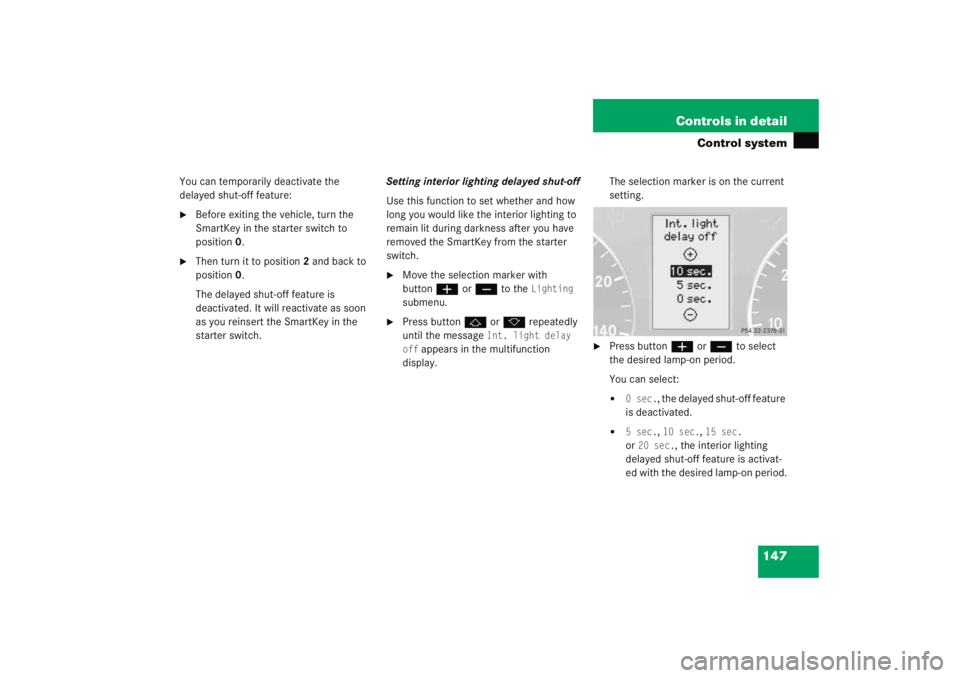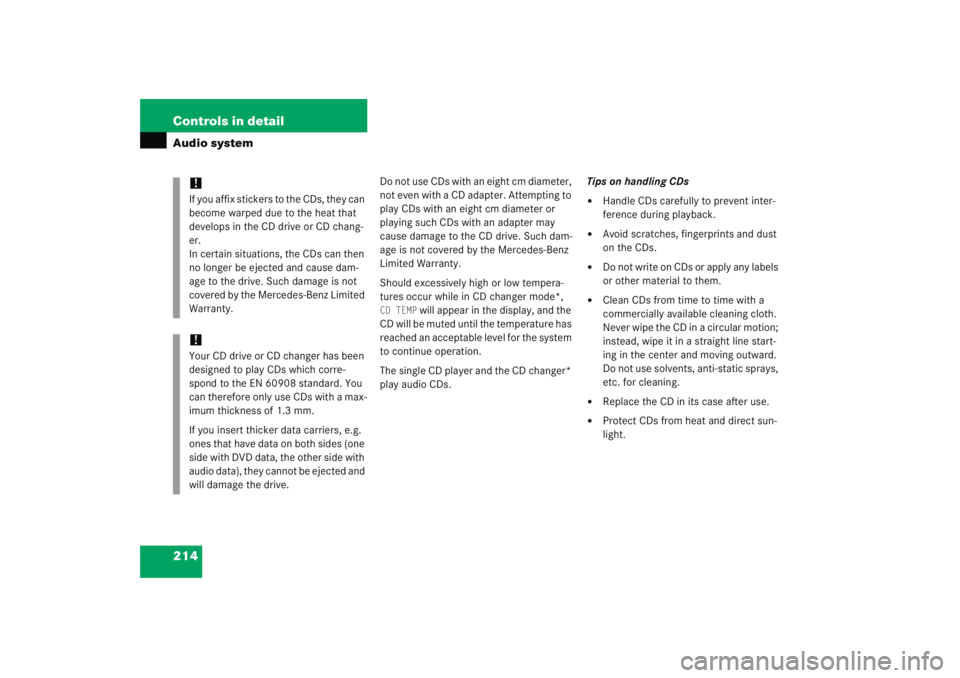Page 147 of 474

146 Controls in detailControl systemSetting night security illumination
(Headlamps delayed shut off)
Use this function to set whether and how
long you would like the exterior lamps to il-
luminate during darkness after exiting the
vehicle and all doors closed.
With the delayed shut-off feature activated
and the exterior lamp switch in
positionU before the engine is turned
off, the following lamps will come on after
you have removed the SmartKey from the
starter switch:�
Parking lamps
�
Tail lamps
�
License plate lamps
�
Side marker lamps
�
Front fog lamps
If you do not open a door after removing
the SmartKey from the starter switch, the
lamps will switch off automatically after
approximately 60 seconds.
�
Move the selection marker with
button æorç to the
Lighting
submenu.
�
Press button jork repeatedly
until the message
Hdlamp delay off
appears in the multifunction display.
The selection marker is on the current
setting.
�
Press button æorç to select
the desired lamp-on period.
You can select:�
0sec.
, the delayed shut-off feature
is deactivated.
�
15 sec.
, 30 sec.
, 45 sec.
or
60 sec.
, select the desired
lamp-on period.
�
Turn the exterior lamp switch to
position U before turning off the
engine (
�page 110).
The headlamps delayed shut-off
feature is activated.
iYou can reactivate this function within
ten minutes by opening a door.
Page 148 of 474

147
Controls in detail
Control system
You can temporarily deactivate the
delayed shut-off feature:�
Before exiting the vehicle, turn the
SmartKey in the starter switch to
position
0.
�
Then turn it to position 2 and back to
position 0.
The delayed shut-off feature is
deactivated. It will reactivate as soon
as you reinsert the SmartKey in the
starter switch. Setting interior lighting delayed shut-off
Use this function to set whether and how
long you would like the interior lighting to
remain lit during darkness after you have
removed the SmartKey from the starter
switch.
�
Move the selection marker with
button
æorç to the
Lighting
submenu.
�
Press button jork repeatedly
until the message
Int. light delay
off
appears in the multifunction
display. The selection marker is on the current
setting.
�
Press button
æorç to select
the desired lamp-on period.
You can select:�
0sec.
, the delayed shut-off feature
is deactivated.
�
5sec.
, 10 sec.
, 15 sec.
or
20 sec.
, the interior lighting
delayed shut-off feature is activat-
ed with the desired lamp-on period.
Page 166 of 474

165
Controls in detail
Automatic transmission*
Driving tips
Accelerator position
Your driving style influences the
transmission’s shifting behavior:
Less throttle Earlier upshifting
More throttle Later upshifting
Kickdown
Use kickdown when you want maximum
acceleration.�
Press the accelerator past the point of
resistance.
The transmission shifts into a lower
gear.
�
Ease on the accelerator when you have
reached the desired speed.
The transmission shifts up again.
Stopping
When you stop briefly, e.g. at traffic lights:
�
Leave the transmission in gear.
�
Hold the vehicle with the brake.
When you stop longer with the engine
idling or on an uphill gradient:
�
Move the gear selector lever to
position P.
�
Set the parking brake. Maneuvering
When you maneuver in tight areas,
e.g. when pulling into parking space:
�
Control the vehicle speed by gradually
releasing the brakes.
�
Accelerate gently.
�
Never abruptly step on the accelerator.
Working on the vehicleWarning!
G
When working on the vehicle, set the
parking brake and move gear selector lever
to position P. Otherwise the vehicle could
roll away.
Page 169 of 474

168 Controls in detailGood visibilityAuto-dimming rear view mirrors*
The reflection brightness of the exterior
rear view mirror on the driver’s side and
the interior rear view mirror will respond
automatically to glare when�
the ignition is switched on
and
�
incoming light from headlamps falls on
the sensor in the interior rear view mir-
ror.
The rear view mirror will not react if
�
reverse gear is engaged
�
the interior lighting is turned on.
Warning!
G
The auto-dimming function does not react if
incoming light is not aimed directly at sen-
sors in the interior rear view mirror.
The interior rear view mirror and the exterior
rear view mirror on the driver’s side do not
react, for example, when transporting cargo
which covers the rear window.
Glare can endanger you and others.Warning!
G
In the case of an accident liquid electrolyte
may escape from the mirror housing if the
mirror glass breaks.
Electrolyte has an irritating effect. Do not
allow the liquid to come into contact with
eyes, skin, clothing, or respiratory system.
In case it does, immediately flush affected
area with water, and seek medical help if
necessary.
!Electrolyte drops coming into contact
with the vehicle paint finish can be
completely removed only while in the
liquid state by applying plenty of water.Warning!
G
Exercise care when using the
passenger-side exterior rear view mirror.
The mirror surface is convex (outwardly
curved surface for a wider field of view).
Objects in mirror are closer than they
appear. Check your inside rear view mirror
or glance over your shoulder before chang-
ing lanes.
Page 171 of 474

170 Controls in detailGood visibility�
Swing sun visors down when you expe-
rience glare.
�
To use mirror, lift up mirror cover2.
Rear window defroster
The rear window defroster uses a large
amount of power. To keep the battery
drain to a minimum, switch off the defrost-
er as soon as the rear window is clear.
The defroster is automatically deactivated
after approximately 6 to 17 minutes of
operation depending on the outside tem-
perature.
Activating�
Press button F or 1 in the
climate control panel (
�page 173) or
automatic climate.
The indicator lamp on the button
comes on. Deactivating
�
Press button
F or 1 in the
climate control panel (
�page 173) or
automatic climate again.
The indicator lamp on the button goes
out.
iIf sunlight enters through a side
window, disengage sun visor from
mounting 1 and pivot to the side.
Warning!
G
Any accumulation of snow and ice should be
removed from the rear window before driv-
ing. Visibility could otherwise be impaired,
endangering you and others.
Page 176 of 474

175
Controls in detail
Climate control
Deactivating the climate control system
Deactivating�
Set air volume control
1 (
�page 173)
to position 0.
Reactivating
�
Set air volume control 1 (
�page 173)
to any speed.
Setting the temperature
Use temperature controls 2 and 3
(�page 173) to separately adjust the air
temperature on each side of the passenger
compartment. You should raise or lower
the temperature setting in small incre-
ments, preferably starting at 72°F (22°C). Increasing
�
Turn temperature control
2 or 3
slightly to the right.
The climate control system will corre-
spondingly adjust the interior air tem-
perature.
Decreasing
�
Turn temperature control 2 or 3
slightly counterclockwise.
The climate control system will corre-
spondingly adjust the interior air tem-
perature.
iWhen the air conditioning is switched
off, the outside air supply and circula-
tion are also switched off. Only choose
this setting for a short time. Otherwise
the windows could fog up.
iWhen operating the climate control
system in automatic mode, you will
only rarely need to adjust the tempera-
ture, air volume and air distribution.
Page 215 of 474

214 Controls in detailAudio system
D o n o t u s e C D s w i t h a n e i g h t c m d i a m e t e r ,
not even with a CD adapter. Attempting to
play CDs with an eight cm diameter or
playing such CDs with an adapter may
cause damage to the CD drive. Such dam-
age is not covered by the Mercedes-Benz
Limited Warranty.
Should excessively high or low tempera-
tures occur while in CD changer mode*, CD TEMP
will appear in the display, and the
CD will be muted until the temperature has
reached an acceptable level for the system
to continue operation.
The single CD player and the CD changer*
play audio CDs. Tips on handling CDs
�
Handle CDs carefully to prevent inter-
ference during playback.
�
Avoid scratches, fingerprints and dust
on the CDs.
�
Do not write on CDs or apply any labels
or other material to them.
�
Clean CDs from time to time with a
commercially available cleaning cloth.
Never wipe the CD in a circular motion;
instead, wipe it in a straight line start-
ing in the center and moving outward.
Do not use solvents, anti-static sprays,
etc. for cleaning.
�
Replace the CD in its case after use.
�
Protect CDs from heat and direct sun-
light.
!If you affix stickers to the CDs, they can
become warped due to the heat that
develops in the CD drive or CD chang-
er.
In certain situations, the CDs can then
no longer be ejected and cause dam-
age to the drive. Such damage is not
covered by the Mercedes-Benz Limited
Warranty.!Your CD drive or CD changer has been
designed to play CDs which corre-
spond to the EN 60908 standard. You
can therefore only use CDs with a max-
imum thickness of 1.3 mm.
If you insert thicker data carriers, e.g.
ones that have data on both sides (one
side with DVD data, the other side with
audio data), they cannot be ejected and
will damage the drive.
Page 238 of 474

237
Controls in detail
Power windows
� Power windows
Opening and closing the windows
The side windows are opened and closed
electrically. The switches for all the side
windows are on the driver’s door. The
switch for the passenger door is on the
passenger door.
1 Left front window
2 Right front window
Warning!
G
When closing the windows, make sure there
is no danger of anyone being harmed by the
closing procedure.
The closing of the door windows can be im-
mediately halted by releasing the switch or,
if switch was pulled past the resistance
point and released, by either pressing or
pulling the respective switch.
If the window encounters an obstruction
that blocks its path in a circumstance where
you pulled the switch past the resistance
point and released it to close the window,
the automatic reversal function will stop the
window and open it slightly.
If the window encounters an obstruction
that blocks its path in a circumstance where
you are closing the window by pulling and
holding the switch, or by pressing and hold-
ing button ‹ on the SmartKey, the auto-
matic reversal function will not operate
When leaving the vehicle, always remove the
SmartKey from starter switch, take it with
you, and lock your vehicle. Do not leave chil-
dren unattended in the vehicle, or with ac-
cess to an unlocked vehicle. Unsupervised
use of vehicle equipment can cause an acci-
dent and/or serious personal injury.